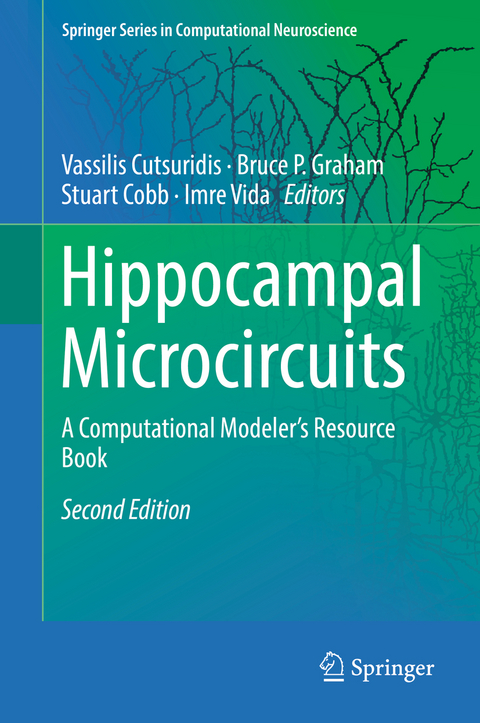
Hippocampal Microcircuits
Springer International Publishing (Verlag)
978-3-319-99102-3 (ISBN)
This is the 2nd edition of a very well received and popular book that reflects the current state-of-the-art of the ongoing research avenues concerning the hippocampus and processing units bridging the gap between single cell activity, network activity and global brain function. It aims to provide a methodology to anyone interested in developing microcircuit level models of the hippocampus.
The book is divided into two thematic areas: (I) Experimental background and (II) Computational analysis. In part I, leading experimental neuroscientists discuss the morphological, physiological and molecular characteristics as well as the connectivity and synaptic properties of the various cell types found in the hippocampus. Behaviour-related ensemble activity patterns of morphologically identified neurons in anesthetized and freely moving animals provide insights on the function of the hippocampal areas. In part II, computational neuroscientists present models of thehippocampal microcircuits at various levels of detail (e.g. single cell level, network level, etc.). Synaptomics and connectomics models of hippocampal structures are initially discussed. Then, network models of memory, rhythm generation and spatial navigation are presented, followed by abstract and biophysical models of synaptic plasticity. Network models of hippocampal implicated disorders (epilepsy and schizophrenia) are then detailed and how their network topologies, connectivities and activities change in these diseases. Finally, two chapters are dedicated to describing simulator environments of single neurons and networks currently used by computational neuroscientists in developing their models and modelling tools to parametrically constrain them.
This engaging volume is invaluable to experimental and computational neuroscientists, electrical engineers, physicists, mathematicians and others interested in developing microcircuit models of the hippocampus. Graduate level students and trainees in all of these fields can find this book a significant source of information.
lt;br />
Preface.- Experimental Background.- Connectivity of the hippocampus.- Morphology of hippocampal neurons.- Physiological properties of hippocampal neurons .- Glutamatergic Neurotransmission in the Hippocampus.- Fast and slow GABAergic transmission in hippocampal circuits.- Synaptic plasticity at hippocampal synapses - experimental background.- Neuromodulation of hippocampal cells and circuits.- cell type-specific activity during hippocampal network oscillations in Vitro.- Recording identified neurons in awake and anesthetized rodents.- Spatial, temporal, and behavioral correlates of hippocampal neuronal activity: A primer for computational analysis.- Computational Analysis.- Systematic data mining of hippocampal synaptic properties.- spatio-temporal patterns of granule cell activity revealed by a large-scale, biologically realistic model of the hippocampal dentate gyrus.- A model of spatial reach in LFP recordings.- Models of rate and phase coding of place cellsin hippocampal microcircuits.- A model for grid firing and theta-nested gamma oscillations in layer 2 of the medial entorhinal cortex.- computational models of grid cell firing .- Modeling synaptic plasticity in hippocampus: a calcium-based approach.-Simplified compartmental models of CA1 pyramidal cells of theta-modulated inhibition effects on spike timing-dependent plasticity .- Factors affecting STDP in the dendrites of CA1 pyramidal cells.- Computational examination of synaptic plasticity and metaplasticity in hippocampal dentate granule neurons .- Genome-wide associations of schizophrenia studied with computer simulation.- Modelling epileptic activity in hippocampal ca3.- A network model reveals that the experimentally observed switch of the granule cell phenotype during epilepsy can maintain the pattern separation function of the dentate gyrus.- Resources for modeling in computational neuroscience.- Experiment-modelling cycling with populations of multi-compartment models: application to hippocampal interneurons .- Index.
| Erscheinungsdatum | 07.01.2019 |
|---|---|
| Reihe/Serie | Springer Series in Computational Neuroscience |
| Zusatzinfo | XVII, 885 p. 182 illus., 120 illus. in color. |
| Verlagsort | Cham |
| Sprache | englisch |
| Maße | 155 x 235 mm |
| Gewicht | 1614 g |
| Themenwelt | Informatik ► Weitere Themen ► Bioinformatik |
| Medizin / Pharmazie ► Studium | |
| Naturwissenschaften ► Biologie ► Humanbiologie | |
| Schlagworte | anatomy • Behavior • Computational Neuroscience • Cortex • declarative memories • hippocampus • Microcircuits • neurons • Physiology • Radiologieinformationssystem • synaptic properties |
| ISBN-10 | 3-319-99102-7 / 3319991027 |
| ISBN-13 | 978-3-319-99102-3 / 9783319991023 |
| Zustand | Neuware |
| Haben Sie eine Frage zum Produkt? |
aus dem Bereich


